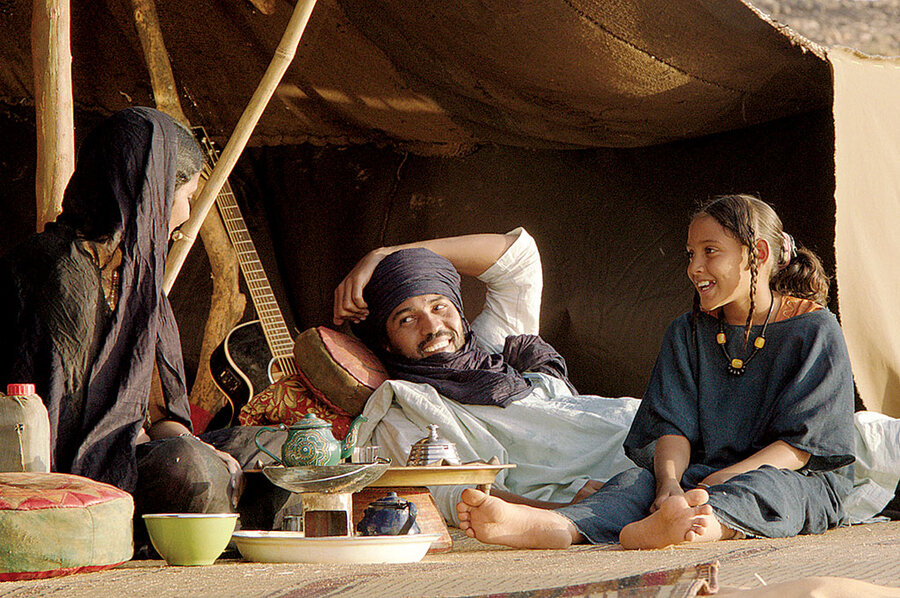'Timbuktu' gives jihadists a human face
Loading...
Jihadism is perpetually ablaze in the news, but the Mauritanian movie “Timbuktu,” a nominee for the best foreign film Oscar, gives those who suffer its condemnations a searingly human face. The film, which was written and directed by Abderrahmane Sissako, also accomplishes the far more difficult feat of giving jihadists a human dimension. This is not the same as endorsing their cause.
The film is set in the early days of the jihadist takeover of northern Mali in 2012, when the city of Timbuktu was overtaken by Tuareg separatists who later were displaced by an Al Qaeda-allied Islamist group. (They in turn were expelled by French and Malian forces in 2013.) Right away we see wanton destructiveness: Jihadists, speaking a mixture of French, English, and Arabic that makes them all but unintelligible to the invaded citizens, machine-gun priceless cultural relics as if they were blasting clay pigeons. This is a prelude to the unutterable tragedies that ensue.
It is to Sissako’s credit that he doesn’t dwell on the graphicness of these horrors. He offers up, as an example, only a very brief shot of two people buried up to the neck – transgressors of sharia (Islamic law) in its most fanatical interpretation – as they are stoned to death. Our imaginations can supply the rest. A seething undertone of violence vibrates throughout “Timbuktu,” but it is ultimately the emotional violence done to these people’s souls that fixates Sissako.
The film’s centerpiece, its emblem of humanity amid all this insanity, is the Tuareg goat and cattle herder Kidane (Ibrahim Ahmed); his wife, Satima (Toulou Kiki); and their 12-year-old daughter, Toya (Layla Walet Mohamed). There is also the local orphan boy (Mehdi A.G. Mohamed) who tends Kidane’s cattle. These people live outside the city in an open tent. Their neighbors have long since fled, but Kidane, who plays his guitar at night under the stars, enjoys the relative freedom that such a life brings. We know before he does that his days are numbered.
In a series of quick, deft brushstrokes, Sissako shows us the sensuousness of this family’s life, and the deep love they have for each other. The beauty of Satima and Toya might seem, in a Hollywood movie, like a fake glamour; here it seems ineffably right – the birthright of those who are pure in heart. This is the beauty that the jihad will decimate far more irrevocably than any relic.
The jihadists are menacingly, grotesquely comic. They carry on heated conversations about the merits of soccer players while officially banning soccer from Timbuktu. In a marvelous scene that says as much as anything else in the film about the persistence of the fighting spirit in a totalitarian system, we see a group of kids playing soccer with an imaginary ball in an open field.
The invaders outlaw smoking and yet smoke on the sly. They condemn adultery but Abdelkerim (Abel Jafri), a Libyan jihadist, ventures out to Kidane’s tent when he is away and makes eyes at the strong-willed Satima while ostensibly demanding she cover her head. At one point, so many things are condemned by the jihadists that a young adherent, using a bullhorn, announces in the city streets a prohibition against doing “any old thing.”
The consequence of disobedience is brought home in the scene in which a group of four musicians, playing at night in their home, are rounded up. The singer, Fatou (the marvelous Malian actress and composer Fatoumata Diawara), is given 40 lashes in a public square, and as she winces and weeps she sings aloud with gathering force.
Kidane’s love for his daughter underscores his fall when he is arrested in a deadly dispute with a local fisherman and condemned to death. He tells his accusers that he fears not death but the thought that he will never see Toya’s face again. God may have given him a daughter instead of a son, he tells them, “but she fulfills my soul.” Her face, ethereal and uncomprehending, lights up the screen as the film fades out.
Sissako, a Muslim, frames his story as a cry against religious intolerance. One of the characters, speaking of jihadism, says, “Where is piety? Where is God in all this?” It is the central question of this movie – and of much more now than this movie. Grade: A- (Rated PG-13 for some violence and thematic elements.)







